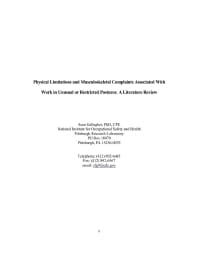Mining Publication: Physical Limitations and Musculoskeletal Complaints Associated With Work in Unusual or Restricted Postures: A Literature Review
Original creation date: January 2005
Authors: S Gallagher
The vast majority of ergonomics research has addressed the demands of work in standing or sitting postures, and understandably so. However, many workers (e.g., underground miners, aircraft baggage handlers, plumbers, agricultural workers, mechanics, and others) are often required to adopt postures such as kneeling, stooping, squatting, or lying down for significant periods of the workday.
A literature search was performed using the ISI Web of Science database (for years 1980-2004). Articles retrieved from this search were evaluated in terms of relevance to assessing physical capabilities of workers in these postures and/or the musculoskeletal epidemiology associated with these postures. Results: Work in unusual and restricted postures was associated with significantly higher rates of musculoskeletal complaints compared to workers not adopting these postures in epidemiology studies (Odds Ratios ranging from 1.13 to 13). Some studies suggested a dose-response relationship, with longer exposures leading to increased musculoskeletal complaints. Physical strength and psychophysical lifting capacity vary significantly as unusual or restricted postures are adopted, with lower lifting capacities evident in the kneeling, squatting, and lying positions.
Workers who adopt unusual or restricted postures appear to be at higher risk of musculoskeletal complaints and often exhibit reduced strength and lifting capacity. Research needs in this area include improved exposure assessment tools, studies of intervention effectiveness, adaptations of the body in response of work in unusual postures, and elucidation of relevant injury pathways. Impact on Industry: Workers who adopt unusual or restricted postures in their work often experience higher musculoskeletal injury rates. If awkward postures cannot be eliminated in the workplace, jobs should be designed in accordance with the reduced strength and lifting capabilities observed in these postures.
